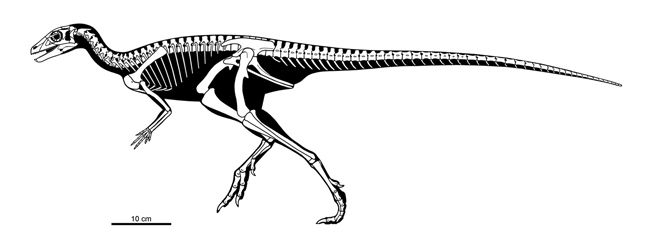Meep-Meep! 'Road Runner' Dino Discovered

Skeletal remains from a 220-million-year-old dinosaur reveal a prehistoric road runner of sorts, whose svelte figure and long legs allowed it to evade predators lickety-split.
The creature stood about 12 inches tall at the hips and weighed just 4.4 pounds. Its head-to-tail length was about 3 feet, with about half of that taken by the tail. The new species is aptly named Eocursor parvus, meaning “early little runner.”
The fox-sized dinosaur is thought to be one of the oldest members of a group of plant-eating dinos called Ornithischians. Later Ornithischians, including the “elephantine” Stegosaurus and Triceratops, evolved from this half-pint, two-legged dinosaur.
“The few Ornithischian fossils from the Triassic are incomplete and controversial, so we know virtually nothing about the group's early evolution,” said lead study author Richard Butler of the Natural History Museum in London.
Fossil features
The remains of Eocursor, including a skull, backbone, arms, pelvis and legs, were unearthed in 1993 in the Lower Elliot Formation in South Africa, but hadn’t been examined until recently.
Butler and his colleagues at the Iziko South African Museum and the University of Cambridge compared the bone structures of Eocursor with other Ornithischian dinosaurs.
Sign up for the Live Science daily newsletter now
Get the world’s most fascinating discoveries delivered straight to your inbox.
They found the species showed certain physical features reminiscent of the earliest Ornithischian dinosaurs, such as relatively large grasping hands with lengthy “fingers.” However, its lengthy hindlimbs, backward-facing pelvis and teeth adapted for plant-eating resembled features of later Ornithischians.
The new dinosaur is detailed online by the journal Proceedings of the Royal Society: Biological Sciences.
Dino family
The scientists produced a new evolutionary tree of the relationships between Ornithischians, finding that Eocursor represented one of the oldest members of these dinosaurs.
How these plant-eating dinosaurs became so dominant has been an open question for paleontologists, with some pointing to the development of certain adaptations for survival and others saying major extinctions provided an empty stage for the Ornithischians to fill.
This study results, revealing the new species already possessed some of these adaptations, point to the extinction idea.
“The end of the Triassic period saw major mass extinctions on Earth, including the extinctions of major herbivorous vertebrate groups,” Butler told LiveScience. “It seems likely that these extinctions created ecological space for herbivores, which Ornithischians were able to expand into and become successful.”
- A Brief History of Dinosaurs
- Images: Dinosaur Fossils
- Avian Ancestors: Dinosaurs That Learned to Fly
Jeanna Bryner is managing editor of Scientific American. Previously she was editor in chief of Live Science and, prior to that, an editor at Scholastic's Science World magazine. Bryner has an English degree from Salisbury University, a master's degree in biogeochemistry and environmental sciences from the University of Maryland and a graduate science journalism degree from New York University. She has worked as a biologist in Florida, where she monitored wetlands and did field surveys for endangered species, including the gorgeous Florida Scrub Jay. She also received an ocean sciences journalism fellowship from the Woods Hole Oceanographic Institution. She is a firm believer that science is for everyone and that just about everything can be viewed through the lens of science.













